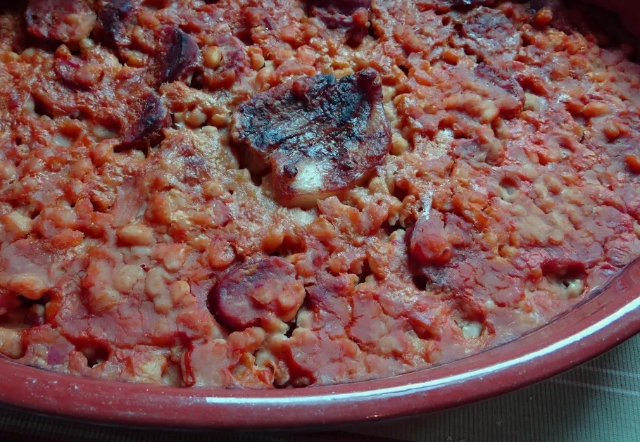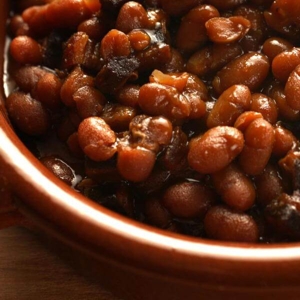This is the time of year that many folks in my part of the world start thinking – some intently – about Bake Beans. Along with the iconic Tourtière Pork Pie, French Canadians consider Baked Beans a New Year’s essential…
 Feijoada: Portuguese Baked Beans
Feijoada: Portuguese Baked Beans
One of my favourite personal traditions attached to the year-end holidays has always been a trip to a certain boucherie (butcher shop) in Ottawa’s east end. There, they feature a huge cast iron kettle full of their own homemade Baked Beans on display every day. Just waiting for customers to scoop up in pints and quarts.
The Quebecois connection to Baked Beans is not usually mentioned when folks set out to recount the dish’s history. But there are several theories about where the ubiquitous side originated.
The French Connection
It’s commonly held – in Quèbec and France – that Baked Beans originated in the mother country of all French speakers around the world. It was hundreds of years ago, in fact. And Baked Beans were widely enjoyed in ‘proto’ form as cassoulet – a bean casserole with many of the characteristics we’ve grown to love in today’s version of the dish.
From there, of course, the dish shipped out with French colonists to what’s now Quebec.
What about New England?
The story goes that European Puritans, fleeing persecution in their home lands, brought French Baked Beans with them to New England. They were a common element of the early cuisine of the Northeast, often featured on Saturday nights.
And that Baked Bean tradition seems finally to have settled itself on Boston and environs. In fact, Boston Baked Beans are considered a distinct variant these days.
What about the Natives?
There is also ample evidence to suggest that the indigenous people of the US Northeast had established their own Baked Bean culture by the time the first Europeans arrived. Beans were apparently baked in earthenware vessels in the coals of a fire. Additions sometimes included maple syrup and venison. But there’s no evidence that those early Puritan arrivals blended their bean habit with that of the locals.
What about the Navy?
Yes, the simple White Bean on which classic baked beans are based is also known as the Navy Bean. It was a staple – alongside Hard Tack (Ship’s Biscuit) – in the British Navy mess halls on land and on sea in the 18th and 19th centuries. However the Navy cooks rarely baked their beans; just stewed then until they yielded up enough starch to make a thin gravy. Add salt pork and you have a typical Navy meal of the period.
The Dawn of canned Baked Beans
This innovation – which goes as far back as the 1860s. But there was no clear focus for the trend. It was in 1895 that entrepreneur Henry J. Heinz first mass-produced Baked Beans sold in cans. He built a whole plant dedicated to them, in Pittsburgh. The Heinz brand became inextricably linked to Baked Beans. They were, in fact, the fist of the famous Heinz 57 Varieties.
British Baked Bean culture
I believe that the British derived their Baked Bean culture partly from the French influence and partly as a relic of the Naval tradition.
But today, the Baked Bean is deeply ingrained in the average British family’s daily diet. They feature Baked beans as an essential component of the famous Full English Breakfast. And even lesser ‘Fry-Up’ versions. Beans on Toast are everyone’s fallback lunch when money is short or time is of the essence.
Baked Beans and Spam has become an icon of the British National Menu.
The Mexican Baked Bean experience
I hear you saying, “Aha! Got you! They don’t have Bake Beans in Mexico!’ Not by the strict interpretation we’ve been using so far in this post. But they do have a rich and colourful Bean Experience. Corn and beans are among the leading Mexican staples. Beans and Rice is a ubiquitous dish south of the border. But more to the point: Classic, authentic Refried Beans may be found in tacos and burritos across the country. And as a side on every restaurant menu. Heck, Frijoles and Refritos constitute a whole bean culture of their own across central America, and Mexico, and throughout the Tex-Mex culinary tradition!
My take
Baked Beans – in their many incarnations – are a staple of every culture influenced by European colonialism. And then some!
We mentioned the French Cassoulet. Then, there’s the Italian Fagioli al Fiasco. And don’t forget Feijoada (black Beans and Meat) from Portugal, exported to virtually every (former) Portuguese colony around the world.
Original ‘Heinz Beanz’ – a vegetarian product – sells big throughout India. But that’s just an aside to the mega-reliance of Indian cooks on a wide variety of beans and lentils. They’re often served up in savoury, spicy sauces analogous to the Tomato- or Molasses-based sauces we’re used to. Ditto China. And much of Southeast Asia…
Use your imagination: How can you creatively incorporate Baked Beans in supper tonight?
~ Maggie J.

